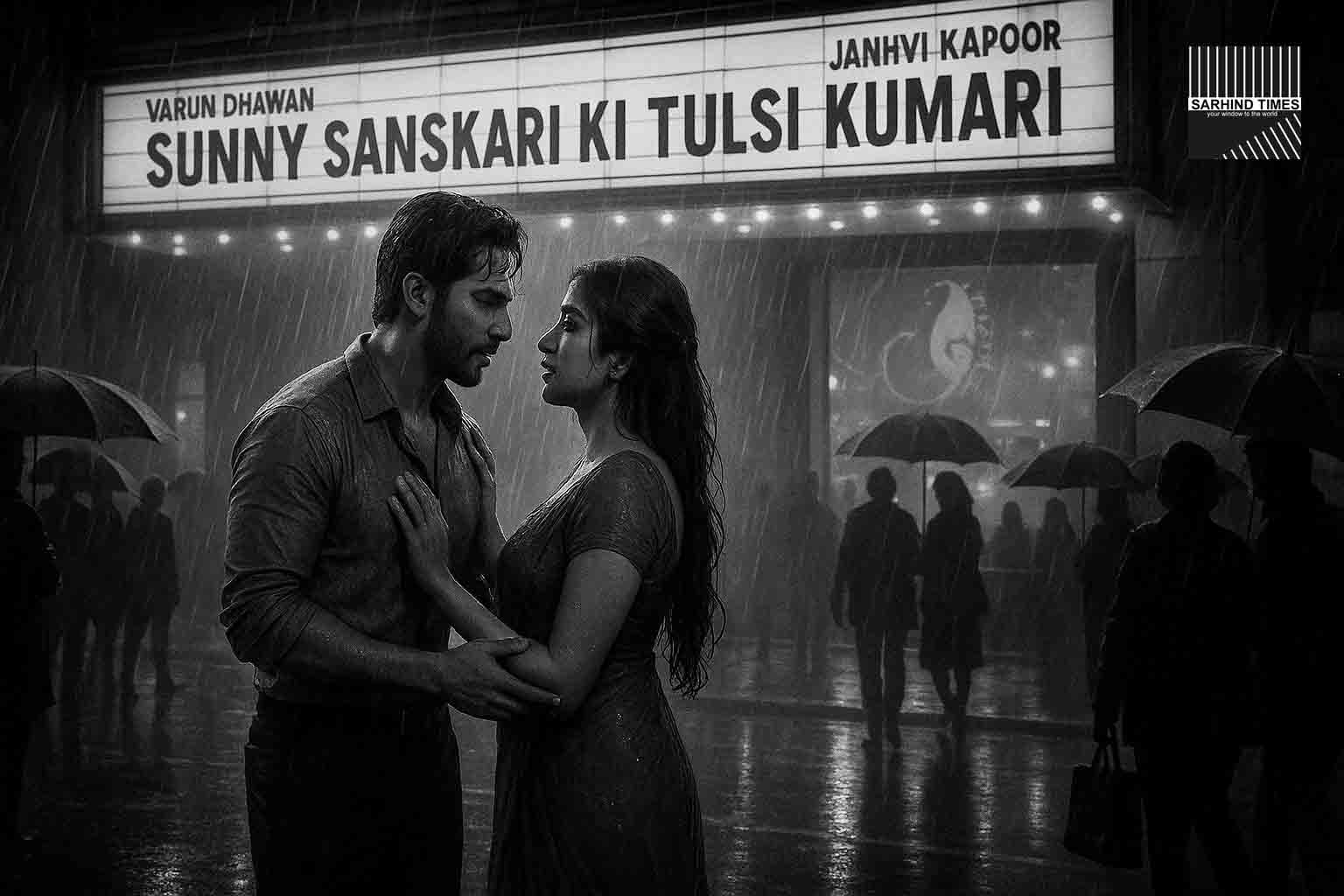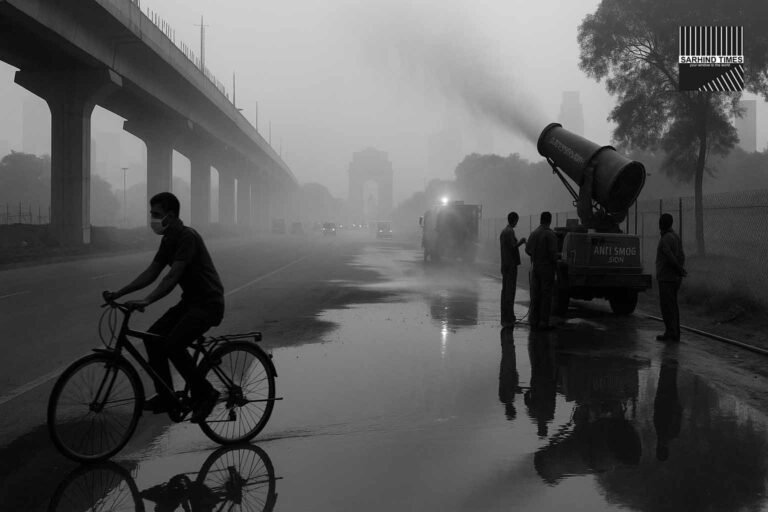The Varun Dhawan–Janhvi Kapoor romantic comedy inches toward the ₹50-crore mark but finds itself overshadowed by Rishab Shetty’s mythic juggernaut Kantara: Chapter 1 in non-metro circuits.
After eleven days at the box office, Sunny Sanskari Ki Tulsi Kumari (SSKTK) has grossed just under ₹50 crore domestically. While the rom-com opened to a strong festive-weekend showing, its pace has moderated due to Kantara: Chapter 1’s cultural storm. With a star-studded ensemble and light-hearted tone, SSKTK continues to draw urban family audiences, but sustaining weekday occupancy remains the key challenge. Source: The Times of India.
🎬 Mumbai, October 13 — A Rom-Com That’s Holding Its Ground
In a season dominated by mythic sagas and folklore epics, a slice-of-life Bollywood rom-com is quietly fighting to keep its space.
Varun Dhawan and Janhvi Kapoor’s Sunny Sanskari Ki Tulsi Kumari (directed by Shashank Khaitan) has crossed ₹48.5 crore in domestic collections at the end of day 11, holding modestly steady despite fierce competition from Kantara: Chapter 1, which continues to sweep the nation’s screens.
Released on October 2, SSKTK emerged as a festive release targeted toward family and urban audiences. Eleven days later, trade analysts describe its performance as “respectable but restrained.”
“It’s a feel-good entertainer that’s found its niche,”
— said Taran Adarsh, senior trade analyst.
“But with Kantara drawing record footfalls, SSKTK’s growth potential has been capped.”
💰 Box Office Snapshot: Slow and Steady
| Day | Collection (₹ crore) | Occupancy Trend |
| Day 1 (Oct 2) | 6.3 | 32% |
| Day 2 | 7.5 | 38% |
| Day 3 (Weekend) | 9.2 | 45% |
| Day 4–7 | 14.6 (combined) | 25% avg |
| Day 8–11 | 10.9 | 23% avg |
| Total (11 Days) | ₹48.5 crore |
The movie’s strong initial weekend, driven by Varun Dhawan’s youth appeal and Janhvi Kapoor’s growing fan base, has gradually tapered off, particularly in Tier-2 markets where Kantara has taken over prime show slots.
Despite that, SSKTK continues to perform better in multiplex circuits like Mumbai, Delhi, and Pune, where family audiences prefer comfort cinema over intensity.
“It’s the kind of film that sustains longer through word-of-mouth and streaming life,”
— commented film exhibitor Akshaye Rathi.
“But theatrical competition has limited its climb.”
❤️ The Story and Spirit of ‘Sunny Sanskari Ki Tulsi Kumari’
Sunny Sanskari Ki Tulsi Kumari tells the story of Sunny Malhotra (Varun Dhawan), a tradition-bound Punjabi wedding planner who unexpectedly falls for Tulsi Kumari (Janhvi Kapoor), a spirited South Indian microbiologist challenging his worldview.
Their clash of cultures, peppered with humor and family drama, becomes a lens to explore modern Indian relationships balancing values and ambition.
“It’s a celebration of imperfection,”
— said director Shashank Khaitan, known for Humpty Sharma Ki Dulhania and Badrinath Ki Dulhania.
“We wanted to make a film that smiles at the audience while saying something meaningful.”
With a supporting cast that includes Sanya Malhotra, Rohit Saraf, and Neena Gupta, the film weaves generational comedy with relatable dilemmas.
Its mix of romantic nostalgia and contemporary emotional realism has resonated most with female and family audiences aged 25–45 — a demographic Bollywood has struggled to retain post-pandemic.
🎞️ Aesthetic and Craft: Old-School Heart in a Modern Frame
Visually, SSKTK blends glossy urban frames with emotional intimacy.
Cinematographer Anil Mehta, known for Kal Ho Naa Ho and Highway, captures vivid cultural juxtapositions — from Delhi’s old neighborhoods to Kochi’s houseboats — giving the rom-com a wide emotional canvas.
The soundtrack, composed by Pritam, anchors the film’s emotional pulse. Songs like “Tera Sanskar, Meri Shiddat” and “Dil Ka Rasam” have gained traction on social media, accumulating over 80 million combined streams on YouTube and Spotify.
“Pritam’s melodies restore that 2000s Bollywood warmth,”
— wrote Film Companion reviewer Anupama Chopra.
“The music feels like home — and that’s its strength.”
🌏 Competition Clash: Kantara’s Storm Looms Large
While SSKTK has found appreciation among metropolitan families, its nationwide growth has been heavily constrained by the juggernaut that is Kantara: Chapter 1.
Rishab Shetty’s mythic epic, rooted in folklore and devotion, has dominated the Indian box office since release, drawing audiences even from Hindi-speaking belts where SSKTK was expected to thrive.
Trade trackers confirm that single-screen exhibitors have replaced some SSKTK shows with Kantara due to higher occupancy.
“In non-metro towns like Jaipur, Indore, and Nagpur, Kantara is filling 90% seats, while SSKTK struggles to cross 35%,”
— said Komal Nahta, trade analyst.
“The genres are worlds apart, but the clash is real.”
Still, SSKTK’s urban foothold gives it resilience — its premium-screen collections (PVR Director’s Cut, INOX Insignia) remain strong, reflecting loyalty among upper-middle-class viewers.
🎭 The Performances: Charm Over Spectacle
Varun Dhawan slips comfortably into his titular role — a character equal parts traditionalist and romantic fool. His comic timing, honed in films like Badrinath Ki Dulhania and Coolie No.1, finds balance here through emotional maturity.
Janhvi Kapoor, playing Tulsi, delivers what critics call her “most lived-in performance yet.” She handles the character’s duality — vulnerability and conviction — with quiet confidence.
“This is the first rom-com in years where both leads feel like real people,”
— wrote The Hindu critic Namrata Joshi.
“Their chemistry is grounded, not manufactured.”
Supporting turns by Sanya Malhotra (as Tulsi’s sarcastic sister) and Rohit Saraf (as Sunny’s idealistic cousin) add emotional humor to the ensemble.
📣 Audience Reaction: A Gentle Wave Amid a Storm
On social media, SSKTK has generated a gentle but consistent buzz.
Fan pages have trended hashtags like #SunnyTulsiChemistry and #BollywoodIsBack, signaling optimism for mid-scale rom-coms in a post-action era.
In contrast to high-decibel blockbusters, many moviegoers have praised the film’s wholesome tone and absence of toxic masculinity — a rarity in mainstream romantic narratives.
“It’s like watching a Karan Johar film written by a therapist,”
— joked one Twitter user.
In Delhi and Mumbai, weekend screenings have seen family audiences returning in groups — a trend distributors say could extend the film’s theatrical shelf life.
📈 Trade Talk: The Economics of a Mid-Range Success
Produced by Dharma Productions on a reported ₹60 crore budget, SSKTK is positioned as a moderate theatrical performer with strong digital and satellite prospects.
- Domestic gross: ₹48.5 crore
- Overseas: ₹9.8 crore
- Worldwide total: ₹58.3 crore
The film is expected to recover costs comfortably through its streaming deal with Amazon Prime Video (₹35 crore) and music rights (₹8 crore).
“Even if theatrical margins remain thin, the digital ecosystem ensures profitability,”
— said Karan Johar, producer, during an interaction at the MAMI Film Festival.
The film’s success underscores a changing Bollywood dynamic — where theatrical returns are supported by OTT lifecycles and global streaming visibility.
🎥 The Return of Bollywood Rom-Coms
For Bollywood, SSKTK represents more than a box-office number — it signals the resurgence of the romantic comedy, once the industry’s beating heart.
Post-pandemic, audiences gravitated toward high-octane action and biopics. But SSKTK, alongside earlier titles like Rocky Aur Rani Ki Prem Kahani, suggests viewers still crave stories rooted in emotion, humor, and humanity.
“Rom-coms may no longer open huge, but they live longer,”
— said trade veteran Amod Mehra.
“They bring families back, and that’s the metric that matters.”
🎞️ Craft Notes: Design, Color, and Symbolism
Production designer Subrata Chakraborty uses vivid palettes to mirror the protagonists’ personalities: warm amber tones for Sunny’s world of rituals and soft blues for Tulsi’s rational, scientific world.
Costume designer Manish Malhotra reinterprets traditional silhouettes — from lehengas inspired by temple motifs to casual saris for everyday wear — blending heritage with modern fashion.
The visual symbolism — mirrors, lamps, and rainfall — recurs throughout, emphasizing reflection, enlightenment, and renewal.
🌍 Overseas Reception: Diaspora Love Story
In the UK, US, and UAE markets, SSKTK has performed above expectations for a mid-budget Hindi film.
Its diaspora-friendly themes — culture, identity, and family — have resonated particularly in London, Toronto, and Dubai, contributing nearly ₹10 crore to its global gross.
Indian expat communities have organized special screenings, with several events hosted by cultural associations highlighting the film’s intercultural marriage narrative.
“It’s refreshing to see Bollywood re-embrace heart over hype,”
— said Sonia Nair, a Toronto-based film programmer.
🔚 Conclusion: A Love Story That Stands Its Ground
Sunny Sanskari Ki Tulsi Kumari may not rewrite box-office history, but it stands as a quiet success — a film that reminds audiences why romance still matters.
Amid a landscape crowded by mythic battles and action set pieces, it offers something deeply human — laughter, love, and lessons about coexistence in a divided world.
If Kantara roars like thunder, SSKTK hums like a song — one that may fade from the headlines but will echo in playlists, hearts, and home screens for months to come.
“Every season needs its storm — and its sunshine,”
— reads one audience tweet.
“Kantara is the storm. SSKTK is the sunshine.”
#BoxOffice #VarunDhawan #JanhviKapoor #Bollywood #Cinema #TradeTalk #SarhindTimes #DharmaProductions























+ There are no comments
Add yours